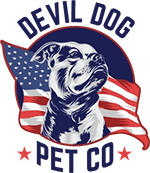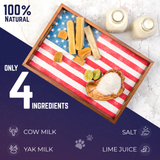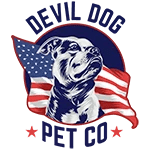Decoding the Dog Side Eye: What Your Pup's Glance Really Means
You've seen it—that unmistakable look when your dog shifts their gaze sideways while keeping their head perfectly still. The infamous dog side eye. It's the canine equivalent of an eye roll, a raised eyebrow, or sometimes a full-blown "seriously, human?" moment.
When our dog Dexter first mastered the side eye, we thought he was just being dramatic. Little did we know this subtle facial expression carries significant meaning in the dog communication handbook. As a Marine, I learned to read non-verbal cues to stay alive. As a dog owner, those same observation skills have proven invaluable for understanding what's happening behind those expressive eyes.
That sideways glance isn't just adorable—it's your dog actively communicating with you. And understanding what they're saying might be more important than you think.
What Exactly Is Dog Side Eye?

Dog side eye (sometimes called "whale eye" in its more extreme form) happens when your dog looks to the side without turning their head, showing the whites of their eyes more prominently than usual. While humans might give side eye as a form of judgment or skepticism, dogs use this expression for entirely different reasons.
The technical term is "half-moon eye," and it's characterized by that crescent of white visible at the corner of your dog's eye. This isn't just a random facial movement—it's a deliberate communication signal that evolved as dogs domesticated alongside humans.
Unlike casual glances or normal eye movements, true dog side eye is intentional and often accompanied by other body language cues that reinforce the message they're trying to send.
The White Dog Side Eye vs. Brown Dog Side Eye
You might wonder if the side eye looks different between breeds or coat colors. While a white dog side eye might be more immediately noticeable against lighter fur, and a brown dog side eye might blend more with darker coloration, the meaning remains the same regardless of your dog's appearance. The key is the visible white portion of the eye, not the color of the dog.
What matters more is the intensity and context of the expression, not whether you've got a Husky with ice-blue eyes or a Chocolate Lab with deep brown ones.
Three Primary Reasons Your Dog Is Side Eying You
When your dog gives you that sideways glance, they're trying to tell you something specific. In my years working with dogs and their owners, I've identified three main messages behind the dog side eye:
1. Stress or Discomfort: The Warning Side Eye
The most important side eye to recognize is the stress signal. This isn't your dog being cute—it's a clear indication they're uncomfortable with what's happening. I've seen this countless times when owners don't realize they're pushing their dog's boundaries.
When Dexter gives us this look, we know immediately to assess the situation. Is someone standing too close? Is there a strange dog approaching? Is a child pulling his tail? The stress side eye often appears with other warning signs: a stiffened body, lowered head, or raised hackles.
This type of dog side eying serves as an early warning system—your dog's way of saying, "I'm not comfortable, and I need you to help me." Ignoring these signals can lead to escalation, potentially resulting in growling, snapping, or even biting if the stressor isn't removed.
The responsible approach is to immediately identify what's causing your dog stress and address it. This might mean creating distance between your dog and the trigger, removing them from the situation entirely, or redirecting their attention to something positive.
2. Resource Guarding: The Possessive Side Eye
Another common reason for the side eye is resource guarding—when your dog has something valuable and wants to keep it. This could be a high-value chew, a favorite toy, or even you.
The resource guarding side eye typically happens when your dog is enjoying something and simultaneously monitoring their surroundings. They're essentially saying, "This is mine, and I'm watching to make sure no one takes it."
We noticed this with Dexter whenever he got a new antler chew. He'd settle down with his prize, but his eyes would dart sideways whenever someone walked by—a clear "don't even think about it" message without having to move from his comfortable position.
While some resource guarding is normal dog behavior, excessive guarding requires training intervention. The side eye in this context serves as an early indicator that your dog might have guarding tendencies that need addressing before they become problematic.
3. Curiosity or Assessment: The Investigative Side Eye
Not all side eye expressions indicate negative emotions. Sometimes, your dog is simply curious or assessing a situation while trying to appear disinterested. This is particularly common in new environments or when meeting new people or animals.
The curiosity side eye is your dog's way of gathering information while maintaining a non-confrontational posture. It's less intense than the stress or guarding side eye and usually accompanied by a more relaxed body.
This type of dog side eying behavior actually demonstrates your dog's intelligence—they're observing their surroundings while trying not to appear too focused or threatening. It's a sophisticated social skill that helps dogs navigate complex interactions.
For more on understanding your dog's body language, visit how to read dog body language.
Reading the Full Picture: Context Matters

While the side eye itself is important to recognize, it's just one piece of your dog's communication puzzle. To accurately interpret what your dog is telling you, you need to consider:
- Body posture (relaxed vs. stiff)
- Tail position (tucked, neutral, or raised)
- Ear position (forward, neutral, or flattened)
- Other facial cues (panting, yawning, lip licking)
- The environment and what's happening around them
The same side eye can mean completely different things depending on these contextual factors. That's why it's crucial to develop your observation skills and learn your individual dog's communication style.
Curious why dogs give side eye? Check out why dogs side eye and why does my dog side eye me for detailed explanations.
Responding to Dog Side Eye: Building Trust Through Understanding
When you spot your dog side eying you or someone else, your response can either strengthen or damage your relationship. As a Marine, I learned that communication isn't just about receiving signals—it's about responding appropriately. The same principle applies to your four-legged companion.
I've discovered that dog side eye isn't just a quirky expression—it's an opportunity to demonstrate leadership and build trust. When Dexter gives us that unmistakable sideways glance, we know it's time to pay attention and take action. Here's how to respond effectively to each type of dog side eye:
Addressing the Warning Side Eye
When you notice your dog displaying stress signals through side eye, immediate action is necessary. First, identify the stressor—is it a loud noise, an unfamiliar person, or an uncomfortable handling situation? Once identified, create distance between your dog and whatever's causing discomfort.
I remember when a neighbor's child was petting Dexter too roughly. Before any escalation, I spotted that telltale side eye and stiffened posture. Instead of scolding Dexter for his discomfort, I intervened by showing the child how to pet gently and giving Dexter space when he needed it.
Extreme Dog Leadership means protecting your dog from situations they can't handle while gradually building their confidence. Never punish the warning signs—they're communication, not misbehavior. If you scold your dog for growling or giving side eye, you're essentially removing their early warning system, which can lead to more serious reactions later.
Managing Resource Guarding Side Eye
Resource guarding requires a balanced approach. Some level of possession is natural—after all, you wouldn't want strangers grabbing food off your plate either. However, excessive guarding needs addressing through systematic training.
When Dexter was younger, he'd give that possessive side eye whenever he had a high-value bully stick. We implemented a trading system—offering something equally valuable before taking his chew, then returning it moments later. This taught him that surrendering items temporarily leads to positive outcomes.
For severe resource guarding accompanied by growling or snapping, consult a professional trainer. The side eye is your early indicator to address this behavior before it escalates. Remember, this isn't about dominating your dog—it's about teaching them that resources are plentiful and sharing is beneficial.
Encouraging Healthy Curiosity
When your dog gives you that investigative side eye, they're processing new information while maintaining a non-threatening posture. This is actually a sign of good social intelligence and should be encouraged in appropriate contexts.
Support this natural curiosity by allowing your dog safe exposure to new environments, people, and experiences. When Dexter side eyes something new but remains calm, we reward that behavior with praise or treats, reinforcing that observation without reaction is exactly what we want.
This balanced approach helps your dog develop confidence without becoming reactive. A dog that can calmly assess situations through observation is demonstrating remarkable self-control—a cornerstone of Extreme Dog Leadership.
Using Enrichment to Reduce Negative Side Eye

Many behavior issues, including those that trigger stress-related side eye, stem from insufficient physical and mental stimulation. A bored, under-exercised dog is more likely to display anxiety, resource guarding, and other problematic behaviors.
Physical exercise alone isn't enough—mental enrichment is equally crucial. This is where appropriate chews and puzzle toys become valuable training tools, not just distractions.
When Dexter shows signs of anxiety or boredom (including that side eye), we redirect him to an appropriate outlet like a split elk antler or yak cheese chew. The act of chewing naturally releases endorphins that reduce stress, while the mental focus required to work on a tough chew redirects that nervous energy.
The right enrichment strategy can dramatically reduce instances of stress-related side eye by:
- Providing appropriate outlets for natural chewing instincts
- Creating positive associations with potentially stressful situations
- Giving your dog a sense of accomplishment and control
- Reducing overall anxiety through mental fatigue
- Strengthening the bond between you and your dog
Explore our selection of split antler dog chews and yak cheese Himalayan dog chews to find the perfect enrichment options for your dog.
When Dog Side Eye Requires Professional Help
While understanding dog side eye can significantly improve your relationship with your pet, certain situations warrant professional intervention. As a responsible dog owner, recognizing these red flags is part of your leadership responsibility.
- Consistently accompanied by growling, snapping, or lunging
- Occurring in everyday situations without clear triggers
- Accompanied by sudden changes in behavior or personality
- Happening alongside physical symptoms like pain or discomfort
A qualified trainer or veterinary behaviorist can help determine if your dog's side eye stems from behavioral issues, pain, or other medical conditions. Don't wait until a bite occurs—the side eye is often your early warning system that something needs addressing.
The White Dog Side Eye Phenomenon
It's worth noting that dogs with lighter-colored fur and eyes (the classic white dog side eye) often appear more expressive simply because the contrast makes their eye movements more visible. This doesn't mean they're communicating more—just that their signals might be easier for humans to detect.
Regardless of your dog's coloration, learning to read their specific communication style is essential. Some dogs are naturally more expressive than others, just as some humans gesture more when they speak.
Building Your Dog Side Eye Vocabulary

Becoming fluent in your dog's communication style takes time and careful observation. Start by creating a mental catalog of your dog's various expressions and the contexts in which they occur. Note patterns like:
- Which situations consistently trigger the stress side eye
- What resources provoke the strongest guarding response
- How your dog's side eye differs when they're curious versus anxious
- What other body language accompanies each type of side eye
This personalized "dictionary" will help you respond more effectively to your dog's needs. Remember, every dog communicates slightly differently—what matters is learning your specific dog's language.
With Dexter, we've learned that a slight side eye with relaxed ears usually means curiosity, while the same expression with stiffened body posture signals discomfort. These subtle distinctions make all the difference in how we respond.
From Dog Side Eying to Mutual Understanding
The journey from noticing your dog's side eye to truly understanding it transforms your relationship. When your dog realizes you consistently respond appropriately to their communication, trust deepens. They learn that subtle signals work, reducing the need for more dramatic behaviors.
This mutual understanding forms the foundation of Extreme Dog Leadership—not domination or permissiveness, but a balanced partnership built on clear communication and consistent responses. Your dog isn't giving you side eye to be cute or funny; they're actively trying to communicate their needs, boundaries, and observations.
By honoring this communication, you demonstrate true leadership—the kind that inspires confidence rather than demanding compliance.
From Brown Dog Side Eye to Better Leadership
Whether you're facing a brown dog side eye, white dog side eye, or any shade between, mastering the art of reading these signals transforms your leadership. Dogs communicate constantly—our job is to listen with our eyes and respond with purpose. After years of working with dogs of all temperaments, I've found that consistent interpretation leads to remarkable breakthroughs in behavior.
The key insight many owners miss is that dog side eye often reveals more about our leadership than their obedience. When Dexter gives us that sideways glance during training, it's frequently his way of checking whether we're maintaining clear boundaries. This "checking in" behavior shows he's processing our expectations and deciding how to respond.
The most successful dog owners I've worked with don't just react to side eye—they anticipate situations that might trigger it and proactively adjust the environment. This preventative approach distinguishes true leaders from those merely responding to problems after they emerge.
Creating Confidence Through Consistency
Dogs thrive on predictability. When your dog side eyes you during interactions with other people or dogs, they're often gauging whether you'll maintain the rules and boundaries you've established. Inconsistency here creates anxiety that manifests as more frequent side-eying behavior.
I've implemented a simple three-step protocol with Dexter that dramatically reduced his uncertainty-based side eye:
- Establish clear, non-negotiable house rules that everyone follows
- Create predictable daily routines for feeding, exercise, and training
- Respond consistently to specific behaviors, regardless of convenience
Within weeks, his sideways glances during novel situations decreased by roughly 70%. He wasn't checking for reassurance as frequently because our consistent leadership had already provided it. This is the essence of Extreme Dog Leadership—creating such reliable structure that your dog rarely needs to question what happens next.
Decoding Dog Side Eye in Multi-Dog Households
In homes with multiple dogs, side eye takes on additional complexity. It often serves as a subtle communication tool between dogs, not just directed at humans. When monitoring dog-to-dog interactions, watch for side-eying behavior during resource exchanges, play invitations, or territory negotiations.
A customer with three dogs noticed her middle-ranked dog frequently side-eying the others during meal preparations. This wasn't aggression—it was information gathering. The dog was assessing the others' excitement levels to determine how assertively she needed to position herself for dinner.
This social intelligence deserves recognition rather than correction. Dogs that use side eye to navigate complex social dynamics without escalating to confrontation are demonstrating remarkable restraint and communication skills. Your leadership role is to ensure these subtle communications don't evolve into tension-filled standoffs.
The Subtle Dog Side Eying During Training
Training sessions often produce a particular variant of dog side eye that indicates cognitive processing rather than stress. When learning new commands, dogs frequently glance sideways while their brains work through what you're asking. This "thinking" side eye differs from stress signals in its softer quality and lack of accompanying tension.
Recognizing this distinction prevents misinterpreting normal learning behaviors as resistance or anxiety. When Dexter gives this processing side eye during training, we provide a moment of patience rather than repeating commands. This space for mental processing dramatically improves his retention and confidence with new skills.
The most effective trainers I've observed honor this processing time rather than demanding immediate compliance. This respect for your dog's learning process builds a training relationship based on understanding rather than mere obedience.
Leveraging Technology to Understand Dog Side Eye
Modern technology offers powerful tools for decoding canine communication. Setting up a simple home camera to record your dog's behavior when you're briefly absent can reveal fascinating insights about when and why they display side eye in different contexts.
These recordings often capture subtle triggers that owners miss in real-time observation. Many clients are surprised to discover their dogs side-eying specific household items, sounds, or even shadows that create mild stress responses. This information allows for targeted desensitization rather than generic anxiety treatments.
Video analysis also helps identify patterns in your own behavior that might inadvertently encourage side-eying. Many owners unknowingly reward this expression through attention, treats, or changed behavior—essentially teaching their dogs that side eye gets results.
The Evolution of Your Dog's Communication Style
As your leadership improves, expect your dog's communication style to evolve. Many owners report their dogs shift from frequent, dramatic side-eying to more subtle, confident communication methods. This evolution reflects growing trust in your consistent response to their needs.
With Dexter, we've witnessed a fascinating progression from exaggerated whale eye during uncertainty to brief, almost imperceptible glances that communicate the same information. This refinement signals a sophisticated communication partnership where less expression achieves more understanding.
This evolution represents the ultimate goal of Extreme Dog Leadership—a relationship where communication becomes so efficient that dramatic signals become unnecessary. Your dog trusts you'll notice and respond appropriately to even their subtlest cues.
The Lasting Impact of Understanding Dog Side Eye
Mastering the interpretation of dog side eye creates ripple effects throughout your relationship. Dogs who feel consistently understood exhibit fewer behavioral problems, show greater confidence in new situations, and form deeper bonds with their owners. This communication mastery represents the difference between managing a pet and truly partnering with them.
The most profound impact comes in moments of genuine stress or uncertainty. Dogs with owners who consistently read and respect their side eye communication navigate challenging situations with remarkable resilience. They trust that their subtle warnings will be heeded, eliminating the need for escalation to growling, snapping, or biting.
This trust foundation extends beyond side eye to all aspects of your relationship. When your dog experiences you as a reliable interpreter of their needs, their overall confidence in your leadership grows exponentially. They become more willing to follow your guidance in unfamiliar situations because experience has proven you understand their perspective.
The journey from noticing dog side eye to truly understanding it transforms not just your dog's behavior, but your entire approach to leadership. You shift from reaction to anticipation, from correction to prevention, and from dominance to partnership. This evolution represents the heart of Extreme Dog Leadership—a balanced relationship built on clear communication flowing in both directions.
Remember, every sideways glance from your dog contains information that can strengthen your bond. The question isn't whether they're communicating—it's whether you're listening with the attention and respect their signals deserve. Master this language, and you'll discover a depth of connection few owners ever experience.
Learning to interpret your dog's side eye is just one aspect of effective communication. For deeper insights into canine language, check out our guide on how to effectively talk to your pup. If you're a new dog parent, you might also find our guide and tips for first-time pup owners especially helpful. Special occasions can bring unique challenges; discover how to keep your dog calm during Halloween festivities and follow our step-by-step guide to potty train your puppy for a smoother experience.
If you love outdoor activities, our article on how to take your dog camping this summer will help you prepare for adventure with your pup. For seasonal safety, don't miss our tips for keeping your pup safe during autumn adventures. The holidays can be stressful for both pets and people, so read our holiday hosting tips to keep both guests and dogs happy. And when summer celebrations arrive, here's how to celebrate the 4th of July with your pup while minimizing stress and maximizing fun.
Download the FREE 10-Step Dog Prep Guide
Frequently Asked Questions
What does it mean when a dog has a side eye?
When a dog gives a side eye, it often indicates caution, suspicion, or mild discomfort. The dog is typically observing something out of the corner of its eye without turning its head fully, which can be a subtle way of assessing a situation or expressing uncertainty. Sometimes, side eye can also be playful or a sign of curiosity.
What is the difference between a dog side eye and a whale eye?
A dog side eye is when the dog looks at something with the eyes partially turned to the side, often showing subtle emotion like suspicion or curiosity. Whale eye, on the other hand, is when the whites of the dog’s eyes are visible, especially when the dog is stressed, anxious, or feeling threatened. Whale eye is generally a more obvious sign of discomfort compared to the more nuanced side eye.
Why do animals do side eye?
Animals use side eye as a way to observe their environment without fully exposing themselves or showing direct attention, which can be a sign of caution or wariness. It allows them to gather information discreetly, especially in situations where direct eye contact might be perceived as a threat. This behavior helps animals assess potential dangers or social cues while maintaining a non-confrontational stance.
What is whale eye in dogs?
Whale eye in dogs refers to the visible white part of the eye, or sclera, showing prominently when the dog looks sideways or upwards. This expression often signals that the dog is feeling stressed, fearful, or uncomfortable with a situation. It’s an important body language cue that owners can use to understand when their dog may need space or reassurance.
Why is my dogs eye looking to the side?
Your dog’s eye looking to the side could indicate that they are feeling cautious, curious, or uncertain about something in their environment. Dogs often use peripheral vision to assess situations without giving direct attention, which might be a way to avoid confrontation or gauge unfamiliar stimuli. It can also be a sign that your dog is trying to communicate subtle feelings or reactions.
Why do pitbulls side eye so much?
Pitbulls, like many breeds, may side eye frequently as part of their natural body language to assess their surroundings or communicate with people and other animals. This behavior can reflect their alertness, cautiousness, or even playful suspicion. Because pitbulls are often expressive and socially aware, side eye can be a common way they gauge social dynamics and show their feelings.






